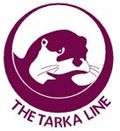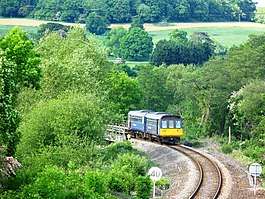Tarka Line
The Tarka Line, also known as the North Devon Line,[1] is a local railway line in Devon, England, linking the city of Exeter with the town of Barnstaple via a number of local villages. Services on the Tarka Line are operated by the Great Western Railway (GWR) and continue across Exeter to terminate at St James Park.[2] In the summer the Dartmoor Railway runs alongside the Tarka Line between Exeter and Yeoford while on summer Sundays GWR services from Exeter operate through to the Dartmoor Railway. The railway broadly follows the route of the A377 road and the River Taw.
| Tarka Line | |
|---|---|
 | |
 Crossing the Exe at Cowley Bridge | |
| Overview | |
| Type | Community rail |
| System | National Rail |
| Status | Open |
| Locale | Devon, England |
| Termini | Exeter St Davids 50.7291°N 3.5438°W Barnstaple 51.0740°N 4.0635°W |
| Stations | 13 |
| Operation | |
| Opened | 1851–1854 |
| Owner | Network Rail |
| Operator(s) | Great Western Railway |
| Depot(s) | Exeter TMD |
| Rolling stock | Class 150 or Class 158 DMUs |
| Technical | |
| Line length | 39 mi (62.76 km) |
| Track gauge | 1,435 mm (4 ft 8 1⁄2 in) standard gauge |
| Old gauge | 7 ft 1⁄4 in (2,140 mm) Brunel gauge |
The first train services between Barnstaple and Exeter were operated in 1854 by the North Devon Railway (NDR), though the track south of Crediton was owned by the distinct Exeter and Crediton Railway (E&CR), which had the permission of the Bristol and Exeter Railway (B&ER) to connect to its station at Exeter St Davids. The NDR was taken over by the London and South Western Railway (LSWR) in 1865, and while the E&CR remained nominally independent, the majority of its shares were owned by the LSWR and the B&ER. The section south of Crediton became part of the LSWR in 1876.
Following the passage of the Railways Act 1921, the LSWR was merged into the Southern Railway, and twenty years later the line became part of the Western Region of British Rail. When British Rail was privatised the line was taken over by Wessex Trains, who gave it the name Tarka Line after the eponymous otter in Henry Williamson's book Tarka the Otter and introduced the Class 150 Sprinters and Class 143 Pacers. The line was transferred to First Great Western in 2006, who rebranded as the Great Western Railway in 2015.
History
Early proposals
The first proposals relating to what would become the Tarka Line originated in the 1820s, when it was proposed that a railway line might be built from Crediton to the docks at Exeter Quayside. Authority was obtained to build this line by an Act of 1831, but the railway was never started and the powers lapsed. However, business interests in Crediton became interested in a railway again after the Bristol and Exeter Railway (B&ER) reached Exeter in 1844 and the South Devon Railway started extending that line to Plymouth. In 1844, the Exeter and Crediton Railway (E&CR) was formed and a proposal was put forward for a new line to connect Crediton to the B&ER.[3] This proposal was accepted and authority was granted by an Act of 1845. The new company had capital of £70,000 (around £8.5 million in modern money), and made arrangements with the B&ER for the latter's trains to run beyond Exeter and along their track to Crediton.
Meanwhile, a proposal from business interests in Barnstaple was put forward in 1845 to build a new line connecting their town to the B&ER at Exeter. This proposal was rejected by the Railway Commission (led by the Lord Dalhousie), as they wished to defer the decision on linking Barnstaple to the national railway network in order to appraise an alternative proposal by the B&ER, who wished to construct a line that would run between Barnstaple and Tiverton, some way up their line towards Bristol.
Route
Communities served: Exeter – Newton St. Cyres – Crediton – Yeoford – Copplestone – Morchard Bishop – Lapford – Eggesford – King's Nympton – Umberleigh – Tawstock – Barnstaple
Parts of the line are single track, meaning that trains travelling in opposite directions must sometimes wait for each other. Collisions are prevented on these sections by requiring the train crew to be in possession of a physical token released from an electrically operated apparatus at a station under a system known as no signaller token remote working.[4] The full journey from Barnstaple to Exeter takes just over 1 hour, much the same as the journey time in a car.
Services
Passenger services on the line are operated by Great Western Railway using Class 150 or Class 158 diesel multiple units. During the summer months a Sunday-only service operates (on behalf of Devon County Council) between Exeter Central and Okehampton.
Passenger volume
The majority of passengers on the Tarka Line travel to or from Barnstaple – about three times the number of all the other stations north of Exeter. Portsmouth Arms is the quietest station in Devon. Some of the smaller stations have seen a decline in passenger numbers during the last few years, although there have been significant increases at Umberleigh, Eggesford, and Copplestone and on the line overall with passenger numbers more than tripled since 2001. [5]
| Station usage | ||||||||||||||||
|---|---|---|---|---|---|---|---|---|---|---|---|---|---|---|---|---|
| Station name | 2002–03 | 2004–05 | 2005–06 | 2006–07 | 2007–08 | 2008–09 | 2009–10 | 2010–11 | 2011–12 | 2012–13 | 2013–14 | 2014–15 | 2015–16 | 2016–17 | 2017–18 | 2018–19 |
| Newton St Cyres | 1,147 | 702 | 780 | 889 | 1,662 | 1,868 | 1,784 | 2,774 | 3,212 | 2,252 | 2,760 | 2,510 | 2,082 | 2,940 | 2,468 | |
| Crediton | 21,607 | 22,478 | 22,550 | 24,021 | 27,422 | 32,344 | 36,784 | 44,074 | 48,978 | 43,016 | 50,342 | 52,492 | 55,112 | 58,390 | 56,006 | |
| Yeoford | 7,993 | 6,883 | 6,848 | 7,701 | 7,445 | 7,946 | 10,504 | 12,948 | 14,164 | 13,746 | 15,588 | 17,128 | 16,450 | 18,580 | 18,156 | |
| Copplestone | 1,231 | 356 | 1,090 | 2,283 | 4,563 | 7,422 | 8,164 | 10,024 | 12,682 | 10,990 | 14,058 | 13,476 | 12,304 | 13,522 | 15,262 | |
| Morchard Road | 4,676 | 3,442 | 2,712 | 2,341 | 2,904 | 4,170 | 6,482 | 8,834 | 11,456 | 11,494 | 11,416 | 11,822 | 12,222 | 13,210 | 12,134 | |
| Lapford | 4,912 | 2,104 | 1,658 | 2,208 | 1,967 | 2,058 | 1,878 | 2,374 | 2,062 | 1,796 | 2,354 | 2,704 | 2,252 | 2,262 | 1,498 | |
| Eggesford | 11,430 | 14,152 | 16,009 | 18,184 | 18,658 | 21,298 | 22,858 | 25,500 | 26,902 | 30,062 | 26,160 | 29,106 | 29,920 | 28,902 | 31,628 | |
| King's Nympton | 4,013 | 2,400 | 1,781 | 1,009 | 1,033 | 1,542 | 1,984 | 2,578 | 3,006 | 4,482 | 3,748 | 3,422 | 5,758 | 8,030 | 6,640 | |
| Portsmouth Arms | 614 | 372 | 510 | 667 | 1,012 | 844 | 676 | 936 | 884 | 694 | 844 | 1,510 | 756 | 518 | 444 | |
| Umberleigh | 7,951 | 8,301 | 10,408 | 12,564 | 13,811 | 16,256 | 17,718 | 19,808 | 22,774 | 31,454 | 34,210 | 37,609 | 31,324 | 37,076 | 34,784 | |
| Chapelton | 734 | 472 | 161 | 120 | 208 | 176 | 162 | 190 | 190 | 258 | 232 | 192 | 100 | 566 | 188 | |
| Barnstaple | 176,682 | 194,474 | 210,846 | 238,082 | 261,174 | 283,920 | 302,998 | 342,328 | 372,438 | 382,186 | 384,234 | 427,394 | 421,346 | 443,450 | 440,404 | |
| The annual passenger usage is based on sales of tickets in stated financial years from Office of Rail Regulation statistics. The statistics are for passengers arriving and departing from each station and cover twelve month periods that start in April. Methodology may vary year on year. Barking and Blackhorse Road are affected by usage of the ticket gates for the underground and that Gospel Oak connects to the North London Line section of the London Overground and is similarly affected. Barking is further affected by the ticket gates used to access C2C services. | ||||||||||||||||
Community rail
| Tarka Line | ||||||||||||||||||||||||||||||||||||||||||||||||||||||||||||||||||||||||||||||||||||||||||||||||||||||||||||||||||||||||||||||||||||||||||||||||||||||||||||||||||||||||||||||||||||||||||||||||||||||||||||||||||||
|---|---|---|---|---|---|---|---|---|---|---|---|---|---|---|---|---|---|---|---|---|---|---|---|---|---|---|---|---|---|---|---|---|---|---|---|---|---|---|---|---|---|---|---|---|---|---|---|---|---|---|---|---|---|---|---|---|---|---|---|---|---|---|---|---|---|---|---|---|---|---|---|---|---|---|---|---|---|---|---|---|---|---|---|---|---|---|---|---|---|---|---|---|---|---|---|---|---|---|---|---|---|---|---|---|---|---|---|---|---|---|---|---|---|---|---|---|---|---|---|---|---|---|---|---|---|---|---|---|---|---|---|---|---|---|---|---|---|---|---|---|---|---|---|---|---|---|---|---|---|---|---|---|---|---|---|---|---|---|---|---|---|---|---|---|---|---|---|---|---|---|---|---|---|---|---|---|---|---|---|---|---|---|---|---|---|---|---|---|---|---|---|---|---|---|---|---|---|---|---|---|---|---|---|---|---|---|---|---|---|---|---|---|
| ||||||||||||||||||||||||||||||||||||||||||||||||||||||||||||||||||||||||||||||||||||||||||||||||||||||||||||||||||||||||||||||||||||||||||||||||||||||||||||||||||||||||||||||||||||||||||||||||||||||||||||||||||||
|
Stations marked with ‡ only operate on summer Sundays only and are on the Dartmoor Railway. Mileage from Exeter St Davids railway station | ||||||||||||||||||||||||||||||||||||||||||||||||||||||||||||||||||||||||||||||||||||||||||||||||||||||||||||||||||||||||||||||||||||||||||||||||||||||||||||||||||||||||||||||||||||||||||||||||||||||||||||||||||||

The Tarka Line is named after the otter in Henry Williamson's book Tarka the Otter which is set in the area. It is one of the railway lines supported by the Devon and Cornwall Rail Partnership, an organisation formed in 1991 to promote railway services in the area. The line is promoted by many means such as regular timetable and scenic line guides, as well as leaflets highlighting leisure opportunities such as walking or visiting country pubs.
The Tarka Line rail ale trail was launched in 2002, the first of several such schemes which encourages rail travellers to visit pubs near the line. The trail originally covered 16 pubs, and the number has risen and fallen over the years, but in 2020 is 11 pubs.[6][7][8] There are three pubs in Exeter and five in Barnstaple, with one each at Lapford, Portsmouth Arms, and Umberleigh. 10 stamps collected in the Rail Ale Trail leaflet entitle the participant to claim special Tarka Line Rail Trail souvenir tour shirt.
Wessex Trains covered Class 150 2-car DMU number 150241 in coloured pictures promoting the line and named The Tarka Belle. It is still in service with Great Western Railway (Formerly First Great Western) but is no longer in that livery.
The line was designated by the Department for Transport as a community rail line in September 2006. This aims to increase revenue and reduce costs. Among possible options are increasing the car parking at stations, looking at ways to increase the train frequency and facilities at stations.
See also
- Tarka Trail
- West of England Main Line
References
- Nicholas, John (20 July 1992). The North Devon Line: Exeter to Barnstaple Railway from Inception to the Present Day. O.P.C. Railprint. ISBN 978-0860934615.
- "Exeter to Barnstaple" (PDF). Great Western Railway. Retrieved 27 January 2020.
- http://great-devon-railway.uk/exeter%20%26%20crediton%20railway/index.html
- Gordon D. Webster (15 November 2016). Signal Boxes and Semaphores: The Decline. Amberley Publishing. p. 88. ISBN 978-1-4456-5618-2.
- "Station Usage". Rail Statistics. Office of Rail Regulation. Retrieved 13 March 2009.
- Falconer, Kieran (6 September 2009). "All abroad the real ale train". Express. Retrieved 18 July 2016.
- Hancock, Nick (16 September 2009). "Rail ale drinkers are back on right track". Express and Echo. Retrieved 18 July 2016.
- "Tarka Line Rail Ale Trail". Great Scenic Railways. Retrieved 18 July 2016.
- Nicholas, John (1992). The North Devon Line. Sparkford: Oxford Publishing Company. ISBN 0-86093-461-6.
- Department for Transport, Rail Group (2006), Route prospectus for the ... Tarka Line'
